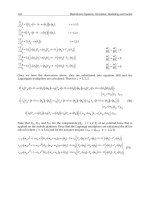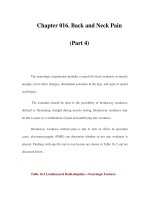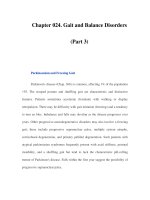Chapter 024. Gait and Balance Disorders (Part 4) pptx
Bạn đang xem bản rút gọn của tài liệu. Xem và tải ngay bản đầy đủ của tài liệu tại đây (13.96 KB, 5 trang )
Chapter 024. Gait and Balance Disorders
(Part 4)
Neuromuscular Disease
Patients with neuromuscular disease often have an abnormal gait,
occasionally as a presenting feature. With distal weakness (peripheral neuropathy)
the step height is increased to compensate for foot drop, and the sole of the foot
may slap on the floor during weight acceptance. Neuropathy may be associated
with a degree of sensory imbalance, as described above. Patients with myopathy or
muscular dystrophy more typically exhibit proximal weakness. Weakness of the
hip girdle may result in a degree of excess pelvic sway during locomotion.
Toxic and Metabolic Disorders
Alcohol intoxication is the most common cause of acute walking difficulty.
Chronic toxicity from medications and metabolic disturbances can impair motor
function and gait. Mental status changes may be present, and examination may
reveal asterixis or myoclonus. Static equilibrium is disturbed, and such patients are
easily thrown off balance. Disequilibrium is particularly evident in patients with
chronic renal disease and those with hepatic failure, in whom asterixis may impair
postural support. Sedative drugs, especially neuroleptics and long-acting
benzodiazepines, affect postural control and increase the risk for falls. These
disorders are important to recognize because they are often treatable.
Psychogenic Gait Disorder
Psychogenic disorders are common in outpatient practice, and the
presentation often involves gait. Some patients with extreme anxiety or phobia
walk with exaggerated caution with abduction of the arms, as if walking on ice.
This inappropriately overcautious gait differs in degree from the gait of the patient
who is insecure and making adjustments for imbalance. Depressed patients exhibit
primarily slowness, a manifestation of psychomotor retardation, and lack of
purpose in their stride. Hysterical gait disorders are among the most spectacular
encountered. Odd gyrations of posture with wastage of muscular energy (astasia-
abasia), extreme slow motion, and dramatic fluctuations over time may be
observed in patients with somatoform disorders and conversion reaction.
Approach to the Patient: Slowly Progressive Disorder of Gait
When reviewing the history it is helpful to inquire about the onset and
progression of disability. Initial awareness of an unsteady gait often follows a fall.
Stepwise evolution or sudden progression suggest vascular disease. Gait disorder
may be associated with urinary urgency and incontinence, particularly in patients
with cervical spine disease or hydrocephalus. It is always important to review the
use of alcohol and medications that affect gait and balance. Information on
localization derived from the neurologic examination can be helpful to narrow the
list of possible diagnoses.
Gait observation provides an immediate sense of the patient's degree of
disability. Characteristic patterns of abnormality are sometimes observed, though
failing gaits often look fundamentally similar. Cadence (steps/min), velocity, and
stride length can be recorded by timing a patient over a fixed distance. Watching
the patient get out of a chair provides a good functional assessment of balance.
Brain imaging studies may be informative in patients with an undiagnosed
disorder of gait. MRI is sensitive for cerebral lesions of vascular or demyelinating
disease and is a good screening test for occult hydrocephalus. Patients with
recurrent falls are at risk for subdural hematoma. Many elderly patients with gait
and balance difficulty have white matter abnormalities in the periventricular
region and centrum semiovale. While these lesions may be an incidental finding, a
substantial burden of white matter disease will ultimately impact cerebral control
of locomotion.
Disorders of Balance
Balance is the ability to maintain equilibrium: a state in which opposing
physical forces cancel. In physiology, this is taken to mean the ability of the
organism to control the center of mass with respect to gravity and the support
surface. In reality, no one is aware of what or where the center of mass is, but
everyone, including gymnasts, figure skaters, and platform divers, move so as to
manage it. Imbalance implies a disturbance of equilibrium. Disorders of balance
present with difficulty maintaining posture standing and walking and with a
subjective sense of disequilibrium, a form of dizziness.
The cerebellum and vestibular system organize antigravity responses
needed to maintain the upright posture. As reviewed above, these responses are
physiologically complex, and the anatomic representation is not well understood.
Failure, resulting in disequilibrium, can occur at several levels: cerebellar,
vestibular, somatosensory, and higher level disequilibrium. Patients with
hereditary ataxia or alcoholic cerebellar degeneration do not generally complain of
dizziness, but balance is visibly impaired. Neurologic examination will reveal a
variety of cerebellar signs. Postural compensation may prevent falls early on, but
falls inevitably occur with disease progression. The progression of a
neurodegenerative ataxia is often measured by the number of years to loss of
stable ambulation. Vestibular disorders have symptoms and signs in three
categories: vertigo, the subjective appreciation or illusion of movement;
nystagmus, a vestibulo-oculomotor sign; and poor balance, an impairment of
vestibulo-spinal function. Not every patient has all manifestations. Patients with
vestibular deficits related to ototoxic drugs may lack vertigo or obvious
nystagmus, but balance is impaired on standing and walking, and the patient
cannot navigate in the dark. Laboratory testing is available to explore vestibulo-
oculomotor and vestibulo-spinal deficits.
Somatosensory deficits also produce imbalance and falls. There is often a
subjective sense of insecure balance and fear of falling. Postural control is
compromised by eye closure (Romberg's sign); these patients also have difficulty
navigating in the dark. A dramatic example is the patient with autoimmune
subacute sensory neuropathy, sometimes a paraneoplastic disorder (Chap. 97).
Compensatory strategies enable such patients to walk in the virtual absence of
proprioception, but the task requires active visual monitoring. Patients with higher
level disorders of equilibrium have difficulty maintaining balance in daily life and
may present with falls. There may be reduced awareness of balance impairment.
Classic examples include patients with progressive supranuclear palsy and normal
pressure hydrocephalus. Patients on sedating medications are also in this category.
In prospective studies, cognitive impairment and the use of sedative medications
substantially increase the risk for falls.









